In-Depth Review of the Panasonic GX85 Camera


Intro
The Panasonic GX85 has emerged as a significant contender in the mirrorless camera segment. With a blend of modern features and a focus on usability, this model aims to cater to both enthusiasts and professionals. Examining its specifications and overall performance helps to clarify its position in the crowded market of imaging devices. This section will outline the fundamental aspects of the GX85, while also hinting at its application in various photographic settings.
Through the detailed analysis that follows, the reader will gain insight into the camera's capabilities, revealing how it can adapt to diverse user needs. The intention is to dissect every element that contributes to the GX85's reputation as an innovative tool in photography.
Features Overview
Key Specifications
The Panasonic GX85 comes equipped with a variety of specifications that enhance its appeal. The camera features a 16-megapixel Micro Four Thirds sensor, enabling crisp, detailed images. It also incorporates Dual Image Stabilization technology, which combines both in-body and optical stabilization, a noteworthy advantage for handheld shooting. Additional specifications include:
- 4K video recording capabilities.
- ISO range of 200-25600, allowing performance in low-light scenarios.
- A 3-inch tilting LCD touchscreen for easier framing and reviewing.
- Wi-Fi connectivity for easy sharing and remote control through smartphones.
Each of these specifications plays a pivotal role in how the GX85 performs. This camera not only focuses on resolution but also enhances the overall shooting experience.
Unique Selling Points
The camera’s unique selling points set it apart from competitors. Firstly, the Dual Image Stabilization is particularly noteworthy; it is a significant feature that minimizes blur and enhances image quality. Another strong point is the 4K photo mode, which allows users to extract high-res stills from video footage. This functionality is particularly beneficial for action shots and reduces the chance of missing a moment.
Furthermore, the user-friendly interface facilitates a seamless transition from automatic settings to manual controls, catering to both novice and experienced photographers. The well-constructed body feels robust yet lightweight, ensuring portability without compromising durability.
Performance Analysis
Benchmarking Results
In test comparisons, the Panasonic GX85 holds its own against key competitors such as the Sony A6000 and Fujifilm X-T20. Many reviews cite its autofocus speed and image quality as standout performances.
• Autofocus Speed: The contrast-detection system works effectively under various lighting conditions. It achieves focus quickly during both stills and video capture. • Image Quality: Color reproduction remains consistent across different lighting environments, a critical aspect for professional users.
Real-world Scenarios
When deployed in real-world scenarios, the GX85 excels in versatility. It functions admirably in both portraiture and landscape photography, thanks to its sharp image quality and dynamic range. Users have reported satisfaction with its performance during low-light conditions, such as evening events, where the ISO capabilities shine.
However, the battery life has occasionally received criticism, which may be a consideration for extended shooting sessions. Ultimately, its effectiveness in capturing both motion and still nature illustrates its adaptability across various environments.
"The Panasonic GX85 proves to be an invaluable asset for photographers seeking quality and versatility without complexity."
This blend of features and performance solidifies the Panasonic GX85's place among desirable mirrorless cameras in today's market.
Preface to the Panasonic GX85
The Panasonic GX85 is an important model in the mirrorless camera segment. Understanding its relevance requires an exploration of its features, performance, and strategic market placement. This section serves as a foundation for discussing the subsequent specifications and usability, allowing for a clear perspective on the camera's capabilities and user experience.
Overview of the Camera
The Panasonic GX85, also known as G85 in some markets, is characterized by its compact design and advanced imaging technology. It features a Micro Four Thirds sensor that captures images with impressive clarity and detail. The dual image stabilization system enhances shooting in various conditions, making it suitable for both photography and videography. With a maximum ISO range of 25600, the GX85 is adept at low-light situations, a notable advantage for enthusiasts and professionals alike.
In terms of usability, the camera is designed with a touch-sensitive LCD screen, allowing for intuitive focus and shutter controls. Additionally, it incorporates a variety of shooting modes that suit different environments and styles, which increases its versatility. Overall, the Panasonic GX85 stands out for its balance between size and functionality.


Positioning in the Market
Positioned within the competitive landscape of mirrorless cameras, the Panasonic GX85 faces formidable rivals such as the Fujifilm X-T20 and Sony Alpha a6300. Its appeal lies predominantly in its dual image stabilization feature, which rivals are still catching up with. The price point is also competitive, making it an attractive choice for both amateur photographers and experienced users.
The camera targets a specific demographic, including those who seek a capable device without requiring the bulk and weight of bulkier DSLRs. Moreover, the marketing strategy of Panasonic emphasizes user-centric design, targeting tech-savvy individuals who value both performance and portability. This niche positioning helps to solidify its standing in a saturated market, offering an alternative that satisfies diverse shooting needs.
The Panasonic GX85 emphasizes a user-friendly experience without sacrificing advanced functionality, setting a benchmark for mirrorless cameras.
Key Specifications of the GX85
Understanding the key specifications of the Panasonic GX85 is crucial for assessing its suitability for various photographic needs. The specifications inform potential users about the camera's capabilities, allowing for informed decisions based on specific needs and shooting conditions. Each aspect, from sensor size to video recording capabilities, provides insights into performance and usability.
Sensor Details
The Panasonic GX85 includes a Micro Four Thirds sensor that offers a 16-megapixel resolution. One significant aspect is its dual image stabilization feature, which combines both optical and electronic stabilization. This capability reduces the effects of camera shake, a common issue in handheld photography. For users, especially those working in dynamic environments, this means clearer images with fewer motion artifacts.
Moreover, the sensor supports a wider dynamic range, capturing detail in both shadows and highlights. In practice, this results in images that retain critical details in challenging lighting conditions. The sensor's performance under various light conditions is also commendable, making it suitable for low-light scenarios, which is vital for event photography.
Image Processor and Performance
The GX85 leverages the Venus Engine, Panasonic's latest image processor, which enhances the camera's overall performance. This processor accelerates the camera's response time, enabling quick shooting. Burst shooting, capable of up to 8 frames per second, is an advantage in capturing fast-moving subjects. This performance is essential in sports or wildlife photography, where timing is critical.
Image quality also benefits from advanced noise reduction algorithms within the processor. This significantly helps in maintaining clarity even at higher ISO settings. Users can expect vibrant colors and sharp details, which contribute to a professional finish in their images. The combination of the sensor and processor thus ensures a seamless shooting experience.
Video Capabilities
Video recording on the GX85 ranges up to 4K resolution at 30 frames per second. This feature positions the camera strongly within the mirrorless category, appealing to videographers looking for high-quality footage in a compact form. It also supports various frame rates, allowing for flexibility in editing and effects like slow motion.
The camera includes V-Log L support, which permits advanced color grading in post-processing. This is ideal for filmmakers who require a professional workflow for their projects. Additionally, the dual image stabilization feature benefits video recording as well, producing smoother footage even during handheld shooting.
Design and Build Quality
The design and build quality of a camera can significantly influence its usability and the user experience. For the Panasonic GX85, these aspects are crucial as they affect not only how comfortable the camera is to handle but also its overall durability and longevity. A well-designed camera will integrate elements that enhance functionality while ensuring it can withstand the rigors of photography in diverse environments. This section delves into the physical dimensions, button layout, and durability features that are fundamental in evaluating the GX85's design.
Physical Dimensions
The Panasonic GX85 boasts compact dimensions, making it particularly appealing for photographers who value portability. Measuring approximately 122 mm x 71 mm x 43 mm and weighing around 505 grams with the battery and memory card, this camera is lightweight and easy to carry. Its size makes it suitable for both casual outings and professional shoots, offering versatility in various settings.
The small form factor does not compromise the camera's performance capabilities. The grip is well contoured, providing a secure hold even during prolonged use. Photographers will appreciate the balance the GX85 strikes between compactness and functionality. Overall, its physical dimensions make it a competitive choice in the mirrorless category, catering to both amateurs and enthusiasts.
Button Layout and Usability
Usability is paramount when evaluating a camera's design. The button layout on the Panasonic GX85 reflects a thoughtful approach to user interaction. Most controls are intuitively placed, allowing quick access to essential functions. The camera features dedicated dials for ISO, shutter speed, and exposure compensation. This design choice enables photographers to make adjustments in real-time without navigating through menus, which is critical during fast-paced shooting situations.
Moreover, the touchscreen functionality enhances usability further. The ability to tap to focus and swipe through images provides a modern interaction experience that aligns with current user expectations. While the overall layout is generally user-friendly, some new users may experience a slight learning curve due to the number of customizable functions available. Nevertheless, once familiar, users will find the layout significantly enhances their shooting experience.
Durability Features
Durability is often overlooked but is a vital component of any camera's design. The Panasonic GX85 is constructed with a robust body that offers resistance to some weather elements, making it suitable for various outdoor settings. The camera features a magnesium alloy frame, which adds to its sturdiness despite remaining lightweight. Coupled with a weather-sealed construction, the GX85 can withstand splashes and dust, providing a degree of protection against the elements.


This durability is particularly advantageous for photographers who frequently shoot in challenging conditions. It instills confidence that the camera can perform without major concerns about damage. Overall, the durability features of the GX85 are a strong selling point, demonstrating Panasonic's commitment to building reliable and resilient photographic equipment.
"A well-constructed camera not only survives the elements but also enhances the photographer's confidence in capturing their vision."
In summary, the design and build quality of the Panasonic GX85 can be seen as a balanced blend of portability, user-friendly controls, and durability. These factors work together to provide an enjoyable shooting experience that is essential for any serious photographer.
Performance Overview
The performance overview of the Panasonic GX85 is critical to understanding how this camera integrates technology and usability to meet the needs of photographers. The performance function encompasses various elements such as autofocus capabilities, image stabilization, and low-light performance. Each of these aspects plays a pivotal role in the overall effectiveness of the camera while shooting in different environments. A clear grasp of these features provides an insight into the camera's responsiveness and reliability, which is essential for both casual and professional photgraphers.
Autofocus System
The autofocus system of the Panasonic GX85 is one of its standout features. It employs a contrast-detection mechanism, enhanced by Depth from Defocus technology. This allows faster and more accurate focusing, especially in challenging shooting conditions. The camera's ability to track moving subjects is also notable.
Here are some key points regarding its autofocus:
- Speed: The autofocus is notably swift, allowing photographers to capture fleeting moments without delay.
- Accuracy: It ensures that focus stays on the intended subject, reducing the chances of missed shots, especially in dynamic environments.
- Flexibility: Users can choose between various focusing modes, offering versatility for different shooting scenarios.
Overall, the autofocus system enhances the user experience by improving hit rates for focus, particularly beneficial in sports and wildlife photography.
Image Stabilization
The image stabilization technology present in the Panasonic GX85 is paramount for achieving clear photos and smooth video footage. This model features a dual image stabilization system that combines both sensor-shift and lens-based stabilization.
Key aspects of this feature include:
- Dual Stabilization: This system significantly reduces camera shake, allowing for sharper images in hand-held shooting situations.
- Video Stability: During video recording, the stabilization technology plays a vital role in preventing jitter and wobble, ensuring professional-quality footage.
- Low Shutter Speed Usability: The stabilization allows for effective use of slower shutter speeds without compromising the image quality, which benefits low-light photography.
The robust image stabilization of the GX85 is essential for users who frequently shoot in varying conditions, enhancing their creative options.
Low-light Performance
Low-light performance is a key consideration for many photographers, and the Panasonic GX85 delivers commendably in this area. The combination of its Micro Four Thirds sensor and high-quality image processor allows for effective noise management and good detail retention at lower light levels.
Some notable points include:
- ISO Range: The GX85 has an expansive ISO range which enables flexibility when shooting in dim conditions.
- Noise Management: Even at higher ISO settings, the camera reduces noise effectively, maintaining clarity and detail in shadows and highlights.
- Aperture Compatibility: The camera performs well with a variety of lenses, especially those with larger apertures, improving performance in low light.
In summary, the low-light capabilities of the GX85 empower photographers to explore creative avenues during twilight or darker environments, expanding their shooting possibilities without significant quality loss.
The performance features of the Panasonic GX85, including its autofocus system, image stabilization, and low-light performance, collectively enhance the camera's usability and effectiveness across diverse photographic situations.
Comparative Analysis
In the context of the Panasonic GX85, the comparative analysis section plays a critical role in understanding how this camera stands relative to its peers. An effective comparison provides potential buyers with insights into the unique features of the GX85. This analysis not only highlights strengths but also reveals weaknesses when placed alongside competing models. Moreover, it helps illuminate the camera's position in an overcrowded market. This is essential for IT professionals and tech enthusiasts who need to make informed purchasing decisions based on technical specifications and real-world performance.
GX85 vs Competitors
When comparing the Panasonic GX85 to its competitors, several key areas are typically under scrutiny. The strength of the camera's dual-image stabilization system, for example, is a notable advantage. This feature provides sharper images in low-light conditions and enhances video stability, setting the GX85 apart from competitors like the Sony Alpha a6300 and Fujifilm X-T20.


Another aspect to consider is the sensor performance. The 16-megapixel micro four-thirds sensor in the GX85 can produce high-quality images while remaining compact. In contrast, the larger sensors of some rivals, while beneficial in certain situations, often result in bulkier bodies. Choosing the right size sensor has significant implications for usability and portability.
Furthermore, the user interface design of the GX85 is intuitive. The menu layout is straightforward, making it easier for both novice and advanced users to navigate the settings. This contrasts with competitors that may present a steeper learning curve due to more complex interfaces.
"When assessing mirrorless cameras, it is crucial to balance performance specifications with practical usability."
Beyond technical specifications, pricing is fundamental in the analysis. The GX85 is often available at a more competitive price point than counterparts like the Canon EOS M50, without sacrificing core features. This value for money can be a compelling reason for users to choose Panasonic over other brands.
Market Positioning Compared
Market positioning refers to how the Panasonic GX85 is perceived in relation to its competition. The GX85 occupies a space designed for enthusiasts who are looking for quality without excessive complexity. It is positioned as a capable yet approachable camera that challenges higher-end models while remaining user-friendly.
An effective argument can be made that Panasonic has successfully targeted a niche market segment, unlike the more generalist approaches of Canon and Nikon. By emphasizing features attractive to travelers, vloggers, and casual photographers, the GX85 carves out a distinct niche.
The marketing strategies also play a significant role in positioning. Panasonic has focused on creating a community around the GX85 by engaging users through social media platforms such as Reddit and Facebook. This strategy helps build an ecosystem of users who share tips and insights, enhancing the overall value of the camera.
User Experience
User experience is a critical aspect when evaluating any camera, including the Panasonic GX85. In modern photography, a camera's usability can significantly influence a user's satisfaction with their gear. This section carefully examines two vital components of user experience: user interface dynamics and the learning curve encountered by new users.
User Interface Dynamics
The Panasonic GX85 possesses a user interface designed to facilitate ease of use. The layout of controls is intuitive, allowing for quick adjustments without excessive complexity. Several tactile buttons and dials enable users to modify settings on the fly. This is particularly important for professional photographers who require immediate access to their camera settings in changing environments.
The touchscreen functionality enhances the user experience further. Users can tap to focus, adjust exposure, and navigate menus smoothly. This level of interaction can increase efficiency, especially in situations where time is crucial. Moreover, the customizable settings let experienced users tailor the interface to their preferences, streamlining workflows and eliminating unnecessary steps.
"User-focused design fosters a more efficient photographic process, ultimately leading to better results."
The button layout is another point of consideration. The placement of essential controls around the grip area allows for a natural hand position during shooting. Combining these design elements with a high-resolution electronic viewfinder offers a cohesive experience, making the GX85 a practical choice for both amateurs and seasoned professionals alike.
Learning Curve for New Users
When discussing the learning curve associated with the Panasonic GX85, several factors come into play. While the camera is packed with features often found in higher-end models, it is designed to be accessible for newcomers. Most basic functions are straightforward, enabling users to start shooting quickly without frustration.
However, mastering all the advanced features may require some study. New users may initially find the variety of settings overwhelming. Tutorials and user guides provided by Panasonic can help bridge this gap, providing step-by-step assistance. Online communities, such as forums on Reddit or Facebook groups, can also be invaluable resources for beginners.
As users gain more experience, they begin to appreciate the depth of options available in the GX85. With practice, many find the camera's full capabilities empowering, allowing creative exploration and expression.
In summary, the user experience of the Panasonic GX85 balances simplicity for beginners with sophistication for experienced photographers. This ensures that it can serve as an effective tool at various skill levels.
Ending
The conclusion offers a critical overview of the Panasonic GX85's overall performance and capabilities. It solidifies the insights gathered throughout the article, reflecting on both the quantitative specifications and qualitative user experiences. This section encourages the reader to synthesize information from previous discussions and formulate an educated judgment regarding the value of this camera in various contexts.
Final Thoughts on the GX85
After a thorough evaluation, the Panasonic GX85 emerges as a well-rounded choice within the mirrorless camera category. Its robust features such as the dual image stabilization and decent low-light capturing capabilities create a compelling argument for both amateur photographers and seasoned professionals. The build quality indicates durability and reliability in fieldwork. The camera's performance in image processing, backed by its capable sensor, should cater well to users demanding high-quality visuals without professional-grade complexity. Each aspect of the GX85 aligns with a strong desire for versatility in varied shooting conditions.
Who Should Consider This Camera
The Panasonic GX85 caters to a wide audience, including:
- Amateur Photographers: Those stepping into mirrorless technology will find the camera's user interface approachable, while its features allow for growth.
- Travel Enthusiasts: Its compact size and lightweight design make it ideal for travel without sacrificing quality.
- Content Creators: With solid video recording capabilities, those focusing on multimedia will appreciate the versatility.
- Tech-Savvy Users: IT professionals looking for innovative imaging solutions might value the GX85’s blend of advanced technology and practical usability.
In summary, the GX85 presents a balanced option for diverse photographic needs. The thoughtful engineering and performance make it suitable for both entry-level users and skilled hobbyists in photography and videography.



